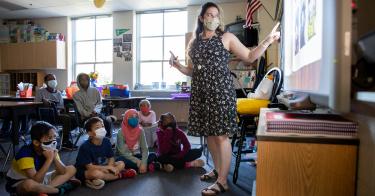Charter schools exist in Virginia, but the law has made it so they’re essentially district schools—rebranded.
For more than 20 years, Virginia’s charter school law—the one governing public schools created by individuals and community leaders seeking to offer more learning options for K-12 students—has felt like a rebranding of the laws for assigned traditional schools.
Lawmakers in nearly every state have enacted charter school laws, and the states with the greatest number—and highest quality—of such schools are those that allow charter schools autonomy and flexibility. Charter schools should be able to enroll any student who applies, from anywhere in the state, subject to space. They should be exempt from teacher hiring and curricular requirements that make them identical to assigned schools, and colleges and independent state boards should be allowed to authorize and oversee charter school operations.
Virginia law strictly limits charter school operations.
>>> Supreme Court Can End Racial Preferences With Harvard and UNC Admissions Cases
Traditionally, school district boards authorize charter schools and charters can only enroll students living in the district’s attendance zone. State law also does not offer charter schools much flexibility from traditional school requirements. Few have bothered to open charter schools in Virginia (the state department of education lists 7 schools, more than half of which are in Richmond and Loudoun County).
The state charter school law needs to be more than a rebranding of traditional school provisions.
Nationally, charter schools serve a larger percentage of children from low-income areas and higher percentages of black and Hispanic students than traditional schools. This means charter schools are accepting significant numbers of students from disadvantaged backgrounds and often report diverse enrollment patterns
Despite enrolling students who are already behind their peers academically and operating with less taxpayer spending than their assigned district schools, charter schools demonstrate remarkable success. According to a new study from University of Arkansas researchers, for every $1 taxpayers invest in charter schools, students gain $8 in lifetime earnings, nearly double the same figure for each taxpayer dollar sent to traditional schools. This return on investment has long-lasting implications for children from low-income homes, the very student population that charters are more likely to serve.
In general, charter school enrollment has increased faster than traditional school enrollment for years. In New York City, charter school enrollment has increased by 9% over the last two years, while traditional school enrollment fell by the same percentage. Research finds that students from charter schools authorized by the state university system in New York outperform traditional schools in both math and reading.
Between 2010 and 2020, Chicago charter schools also saw enrollment increases while traditional schools experienced steep declines. RAND researchers found that the average student who entered a charter school in 8th grade and finished his or her high-school experience at a charter scored higher on the ACT than their peers at traditional schools and was more likely to graduate and enroll in college.
>>> Why Parents Need Choices in Education To Protect Their Values
University of Chicago researchers found that the city’s charter schools were more likely to enroll students whose eighth-grade test scores were similar to or lower than students in non-charter schools but that, on average, charter school students had higher attendance rates and demonstrated higher achievement levels on standardized tests than their peers.
In Virginia, black students score at least 20 points lower than their white peers in math and reading on national comparisons in fourth and eighth grades. Again, these are the students—both in terms of ethnicity and preparedness—that charter schools around the U.S. have been more likely to serve.
Gov. Glenn Youngkin recently said that “choice and innovation within public education is vital” to helping students succeed. There is little of either of these now among Virginia’s public schools—but public charter schools have the potential to offer a life-changing amount of both for students.
This piece originally appeared in Virginia Works




